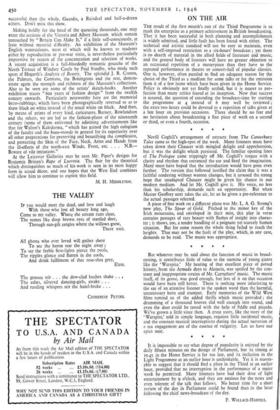ART
MESSRS. TOOTH have produced for us an early Constable View of Chatham, painted, it is assumed, after the artist'•s trip from London to Deal in an East Indiaman at the age of 27, and newly discovered in a small country house near Ne..vbury. Constable at this time wa,s without financial or other worries ; the picture is fresh and spacious and happy. On the side of a hill three boys are preparing to raise a kite into a lightly clouded sky of pellucid cerulean (the result, perhaps, of Benjamin West's advice to " keep the sky bright "). Behind and beyond, the undulating fields give way to a prospect of the town and the harbour, in which men-of-war and other shipping may be seen at anchor. The influence of Gains- borough is clear in places ; the anxiety over detail, which was to lead subsequently to the elaboration of the later sketches, here takes an almost Breughel-like form in the more distant figures and buildings. It is a picture not only of historical interest, however, but also of great charm and beauty. Although the main emphasis has been placed upon the Constable, the other acquisitions in this exhibition are scarcely less delightful. For novelty there is a palette-knife Pissaro ; for tranquillity a lovely Boudin in which the tone of the water is exact ; for innocence an admirable early Corot ; for detectives Hogarth's so-called Thornhill Family ; for benefactors the centre panel of a predella for an altar-piece by Bartolommeo di Giovanni, the adjoining panels of which are in the Walker Art Gallery, Liver- pool ; for psychologists Quentin de la Tour's self-portrait. There are also an English Canaletto, an early Monet, constructed round the dominant yellow-grey of a breaking wave, a big Crome, parts of which—the boat on the extreme left, for example—seem more
successful than the whole, Guardis, a Ruisdael and half-a-dozen others. Don't miss this show.
Making boldly for the head of the queueing thousands, one may enter the sections of the Victoria and Albert Museum which remain untouched by " Britain Can Make It," if a little self-consciously, at least without material difficulty. An exhibition of the Museum's English watercolours, most of which will be known to students either by reproduction or pre-war visits, is nevertheless particularly impressive by reason of the concentration and selection of works. A recent acquisition is a full-bloodedly romantic gouache of the North Terrace of Windsor Castle by Paul Sandby, who made such sport of Hogarth's Analysis of Beauty. The splendid J. R. Cozens, the Palmers, the Cotmans, the Boningtons and the rest, demon- strate again the strength and richness of the Museum's collections. Also to be seen are some of the artists' sketch-books. Another exhibition traces " 600 years of fashion design " from the twelfth century onwards. Particularly noteworthy here are the memorial brass-rubbings, which have been photographically reversed so as to show black on white instead of the usual white on black. And then, by means of prints of every kind, caricatures, Burney, Rowlandson and the others, we are led to the fashion-plates of the nineteenth century (some of them enlivened by adjoining advertisements like that for Walton's Kaloderma, " which has gained the high eulogium of the faculty and the beau-monde in general for its superiority over all other preparations for preserving and beautifying the complexion, and protecting the Skin of the Face, Neck, Arms and Hands from the ill-effects of the north-east Winds, Frost, etc. . . N.B.- Beware of vile imitations."
At the Leicester Galleries may be seen Mr. Piper's designs for Benjamin Britten's Rape of Lucretia. The flair for the theatrical which distinguishes so much of his work is seen in its most happy form in actual decor, and one hopes that the West End combines will allow him to continue to exploit this field.
M. H. MIDDLETON.



































 Previous page
Previous page